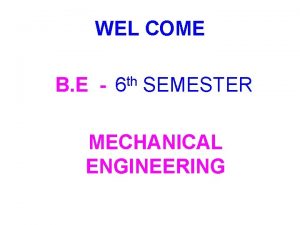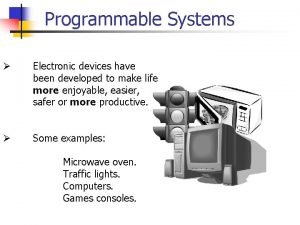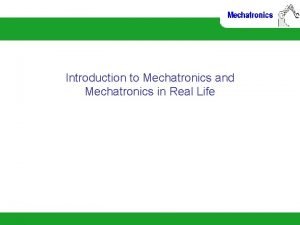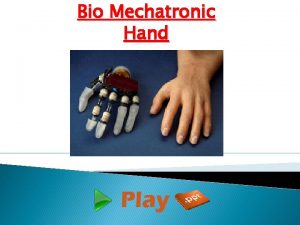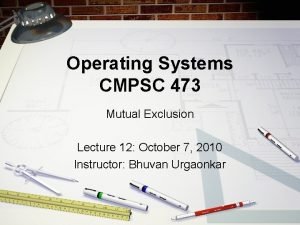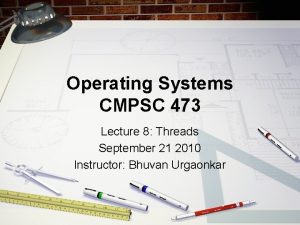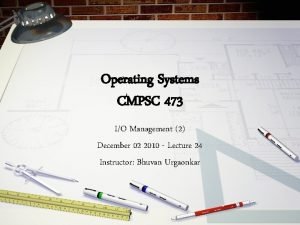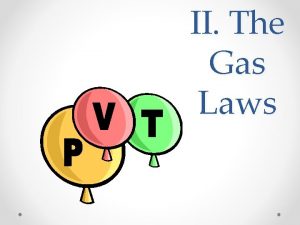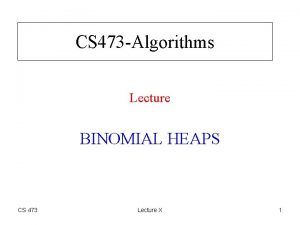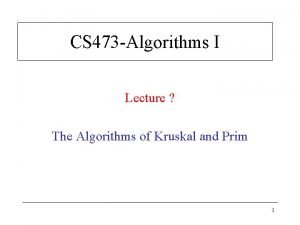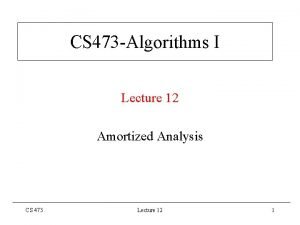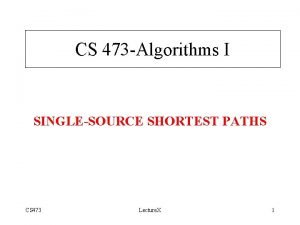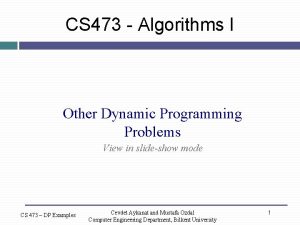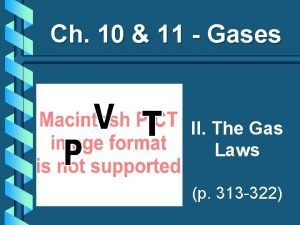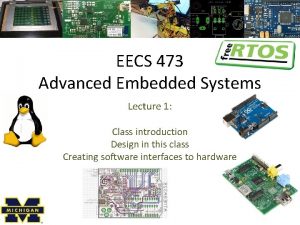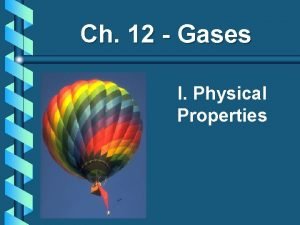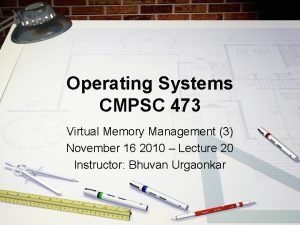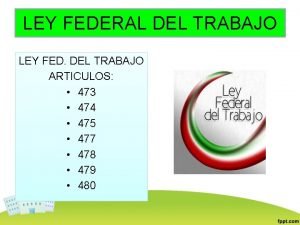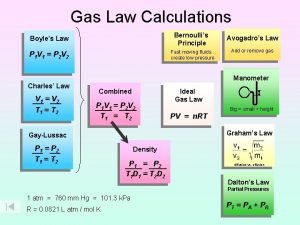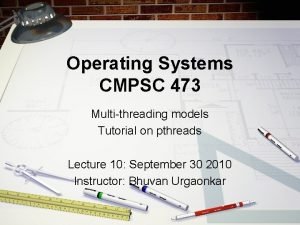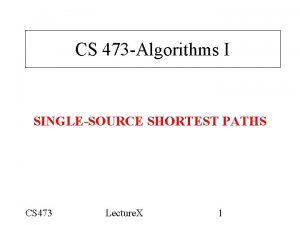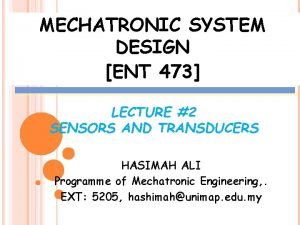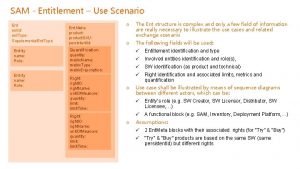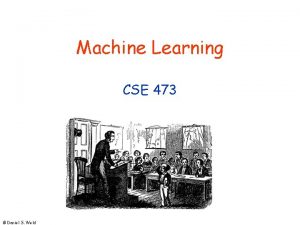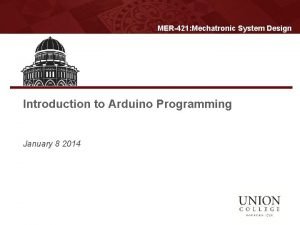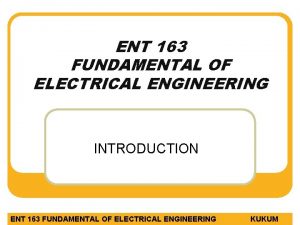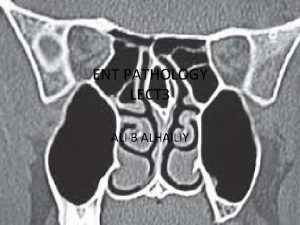MECHATRONIC SYSTEM DESIGN ENT 473 LECTURE 5 SYSTEM
![MECHATRONIC SYSTEM DESIGN [ENT 473] LECTURE #5 SYSTEM MODELING& RESPONSES HASIMAH ALI Programme of MECHATRONIC SYSTEM DESIGN [ENT 473] LECTURE #5 SYSTEM MODELING& RESPONSES HASIMAH ALI Programme of](https://slidetodoc.com/presentation_image_h/b88a00cc60ab82e28eb080c09444c097/image-1.jpg)







































- Slides: 40
![MECHATRONIC SYSTEM DESIGN ENT 473 LECTURE 5 SYSTEM MODELING RESPONSES HASIMAH ALI Programme of MECHATRONIC SYSTEM DESIGN [ENT 473] LECTURE #5 SYSTEM MODELING& RESPONSES HASIMAH ALI Programme of](https://slidetodoc.com/presentation_image_h/b88a00cc60ab82e28eb080c09444c097/image-1.jpg)
MECHATRONIC SYSTEM DESIGN [ENT 473] LECTURE #5 SYSTEM MODELING& RESPONSES HASIMAH ALI Programme of Mechatronic Engineering, . EXT: 5205, hashimah@unimap. edu. my

Outlines • • • Plant Modeling Mechanical System Electrical System Hydraulic System Pneumatic System Thermal System

Plant Modeling And Simulation q Modeling is the process of representing the behavior of real system (physical system) by collection of mathematical equation. q The term mathematical model, in the control engineering perspective, implies a set of differential equations that describe the dynamic behavior of a process.

Plant Modeling q The set of differential equations that describe the behavior of physical systems are typically obtained by utilizing the physical laws of the process.

Plant Modeling How to obtain the mathematical models? • Physical laws of the process Differential equations Electrical system Kirchhoff's laws Mechanical system Newton's laws Fluid system ? Thermal System ?

Plant Modeling Example: Gantry Crane System

Mechanical System q Basic building blocks representing mechanical systems are: v Spring v Dashpots/ damper v Masses q All these blocks have a force as an input and a displacement as output.

Mechanical System q For mechanical system, the basic building block are springs, dashpots and masses.

Mechanical System 1. Example: Spring-Mass-Damper State Space Representation

Mechanical System Exercise 1 1. A spring-mass-damper is shown in figure below, obtain the: a. transfer function, b. state space representation and c. block diagram representation

Mechanical System Exercise 1 Derive a model for the mechanical system represented by the system of mass, spring and dashpot given in Figure below. The input to the system is the force F and the output is the displacement y.

Mechanical System Example: Suspension System x 1 m 1 k 1 x 2 W b U m 2 k 2 A quarter car model

Mechanical System Example: Rotational system q For rotationals system, the basic building block are a torsional-spring, a rotary damper and the moment of inertia.

Rotational System

Rotational System Rotational system

Rotational System Example: Develop a model of a system shown in Figure, of the rotation of the disk as a result of twisting a shaft.

Electrical System q For electrical system, the basic building block are a resistor, inductor and capacitor.

Electrical System Capacitor For a capacitor, the potential difference v across it depends on the charge q on the capacitor plates with v = q/C, where C is the capacitance. Thus: Since current / is the rate of movement of charge:

Electrical System Example: RLC Circuit.

Electrical System Exercise 2 Develop a model for a d. c. permanent magnet motor relating the current through the armature to the applied voltage.

Analogies: Electrical and Mechanical 1. The mechanical analogue of the resistor is the dashpot. 2. In this case the current can be analogues to the force , then the potential difference is analogues to the velocity and the dashpot constant c to the inverse of R. 3. These analogies between current and force, potential difference and velocity, hold also for the other building blocks. 4. Spring is analogues to inductance, mass is analogues to capacitance.

Hydraulic System 1. In fluid systems there are 3 basic building blocks are resistance, capacitance and inductance. 2. Volumetric rate of flow q is equivalent to current. 3. Pressure difference (p 1 -p 2) is equivalent to electrical potential difference. 4. Fluid systems can be considered to fall into 2 categories: 1. Hydraulic 2. Pneumatic

Hydraulic System Hydraulic Resistance Hydraulic resistance R is the resistance to flow which occurs when a liquid flows from one diameter pipe to another and is defined as being given by the hydraulic equivalent of Ohm's law:

Hydraulic System Hydraulic Capacitance • • Hydraulic capacitance C is the term used to describe energy storage where the hydraulic liquid is stored in the form of potential energy. The rate of change of volume V of liquid stored is equal to the difference between the volumetric rate at which liquid enters the container q 1 and the rate at which it leaves q 2, i. e.

Hydraulic System Hydraulic Capacitance The pressure difference between the input and output is: p 1 -p 2=ρgh Hence, substituting for h gives: The hydraulic capacitance C is defined as:

Hydraulic System Hydraulic inertance • Consider a block of liquid of mass. The net force acting of the liquid will cause the mass to accelerate with an acceleration a,

Hydraulic System Example 3 Develop a model for the hydraulic system shown in Figure below where there is a liquid entering a container at one rate q 1 and leaving through a valve at another rate q 2. For capacitance: For resistance:

Pneumatic System • With pneumatic systems the three basic building blocks are as with hydraulic system; resistance, capacitance and inertance. • However, gasses differ from liquids in being compressible. • A change in volume causes a change in pressure and a change in density.

Pneumatic System q Pneumatic resistance R is defined in terms of the mass rate flow dm/dt and the pressure difference p 1 -p 2. p 1 -p 2 =R dm/dt q Pneumatic capacitance is due to the compressibility of the gas and is comparable to the way in which the compression of a spring stores energy. q If there is a mass rate of flow dm 1/dt entering the container of volume V and a mass rate of flow of dm 2/dt leaving it, the rate at which the mass in the container is changing is (dm 1/dt-dm 2/dt)

Pneumatic System Rate of change of mass in container: Since, for idea gas, and, with consequent

Pneumatic System Then, rate of change of mass in container: thus, Pneumatic capacitance due to change in volume. Pneumatic capacitance due to compressibility of the gas

Pneumatic System hence , or,

Pneumatic System Analysis of Pneumatic System q Mass flow rate : q All the gas remains in the container:

Thermal System q There are only two basic building blocks for thermal systems; § Resistance § Capacitance.

Thermal System Thermal Resistance q If q is the rate of flow of heat and (T 1 -T 2) the temperature difference, then: (a) Thermal resistance, (b) thermal capacitance

Thermal System Thermal Resistance q The value of resistance depends on the mode of transfer: v Unidirectional conduction: v Hence v Convection: , hence

Thermal System Thermal Capacitance q Is the measure of internal energy storage. Rate of change of internal energy = q 1 -q 2. q Where m is the mass and c is the specific heat capacity. q Hence, where C=mc

Thermal System Example of Thermal Systems 1. Consider a thermometer at temperature T which has just been inserted into a liquid at temperature TL. If thermal resistance to heat flow from the liquid to thermometer is R,

Thermal System Example of Thermal Systems § Since there is only a net flow of heat from the liquid to thermometer, q 1=q and q 2=0. Thus,

Further Readings 1. Godfrey C. Onwubolu, “Mechatronics: Principles and Applications”. • Chapter 7 2. D. G. Alciatore and M. B. Histand, "Introduction to Mechatronics and Measurement Systems • Chapter 5
 Mechatronic concept design
Mechatronic concept design Mechatronic devices examples
Mechatronic devices examples Mechatronic devices examples
Mechatronic devices examples Examples of mechatronics system in daily life
Examples of mechatronics system in daily life Mechatronic software integrator
Mechatronic software integrator Bio mechatronic hand
Bio mechatronic hand Mechatronic systems rolf isermann
Mechatronic systems rolf isermann 01:640:244 lecture notes - lecture 15: plat, idah, farad
01:640:244 lecture notes - lecture 15: plat, idah, farad Cmpsc 473
Cmpsc 473 Cmpsc 473
Cmpsc 473 Cmpsc 473
Cmpsc 473 What is k in boyle's law
What is k in boyle's law Eecs473
Eecs473 Cs 473
Cs 473 Kruskal algorithm in c
Kruskal algorithm in c Cs 473
Cs 473 Characteristics of gases
Characteristics of gases Round 236 to the nearest ten
Round 236 to the nearest ten Uw cse 473
Uw cse 473 Static single assignment
Static single assignment Cs 473
Cs 473 Cs 473
Cs 473 K=pv
K=pv A gas occupies 473 cm3 at 36°c. find its volume at 94°c
A gas occupies 473 cm3 at 36°c. find its volume at 94°c Nuvw
Nuvw Cs 473
Cs 473 Eecs 473
Eecs 473 Eecs 473
Eecs 473 A gas occupies 473 cm3 at 36°c. find its volume at 94°c
A gas occupies 473 cm3 at 36°c. find its volume at 94°c Cmpsc 473
Cmpsc 473 Ley fed del trabajo
Ley fed del trabajo Factors of 473
Factors of 473 A gas occupies 473 cm3 at 36°c. find its volume at 94°c
A gas occupies 473 cm3 at 36°c. find its volume at 94°c Multithreading models in os
Multithreading models in os Cs 473
Cs 473 Eurocode lap lengths
Eurocode lap lengths Urban design lecture
Urban design lecture Elements of interior design ppt
Elements of interior design ppt Lecture hall background
Lecture hall background Game design lecture
Game design lecture Computer-aided drug design lecture notes
Computer-aided drug design lecture notes

